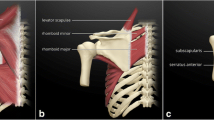Abstract
Scapulothoracic bursitis contributes to considerable morbidity in some patients with scapular pain. A scapulothoracic bursa injection can induce symptomatic relief; however, blind injections into the scapulothoracic bursa may involve injecting into the subscapularis muscle itself. The aim of this study was to compare the therapeutic effects of intramuscular injections into the subscapularis under ultrasound (US) guidance with those of blind scapulothoracic bursa injections in patients with scapular pain. This study was a single-center, prospective, randomized, single-blinded, controlled clinical trial. Thirty-six patients with suspected scapulothoracic bursitis, who met the inclusion criteria, were recruited between January 2009 and December 2012. We performed three US-guided intramuscular injections into the subscapularis muscle or three blind scapulothoracic bursa injections at 1-week intervals. A visual analogue scale (VAS) and the Rubin scale at baseline and at 1, 2, and 3 weeks after the last injections were examined and again at 3 months after the last injections by a blinded investigator. Adverse effects were monitored. The VAS scores at baseline were 7.7 ± 1.3 and 7.8 ± 1.4 in the intramuscular injection and scapulothoracic bursa injection groups, respectively. Mean VAS scores after the intramuscular injections were 3.8, 2.7, 1.3, and 3.5, and mean VAS scores after scapulothoracic bursa injections were 4.1, 2.4, 1.6, and 2.9 at 1, 2, 3 weeks and at 3 months after the last injections. VAS scores decreased significantly after the injections in each group (p ≤ 0.05). However, no significant difference was observed between intramuscular injection into the subscapularis and the scapulothoracic bursa injection. No serious complications were encountered. In conclusion, injections at the scapulothoracic bursa without US guidance did not exclude the possibility of an effect of steroid on the subscapularis muscle, as both intramuscular injections into the subscapularis and scapulothoracic bursa injections in patients with scapular pain provided equal symptomatic relief, and all patients developed tenderness in their subscapularis muscle.




Similar content being viewed by others
References
Nicholson GP, Duckworth MA (2002) Scapulothoracic bursectomy for snapping scapula syndrome. J Shoulder Elbow Surg 11:80–85
Gaskill T, Millett PJ (2013) Snapping scapula syndrome: diagnosis and management. J Am Acad Orthop Surg 21:214–224
Sisto DJ, Jobe FW (1986) The operative treatment of scapulothoracic bursitis in professional pitchers. Am J Sports Med 14:192–194
Chang WH, Im SH, Ryu JA, Lee SC, Kim JS (2009) The effects of scapulothoracic bursa injections in patients with scapular pain: a pilot study. Arch Phys Med Rehabil 90:279–284
Muscolino JE (2009) The muscle and bone palpation manual with trigger points, referral patterns, and stretching. Mosby Inc., St. Louis
Rha DW, Han SH, Kim HJ, Won SY, Lee SC (2012) Ultrasound-guided lateral approach for needle insertion into the subscapularis for treatment of spasticity. Arch Phys Med Rehabil 93:1147–1152
Liu WH, Aitkenhead AR (1991) Comparison of contemporaneous and retrospective assessment of postoperative pain using the visual analogue scale. Br J Anaesth 67:768–771
Rubin D (1960) Cervical radiculitis: diagnosis and treatment. Arch Phys Med Rehabil 41:580–586
Lehr R (1992) Sixteen S-squared over D-squared: a relation for crude sample size estimates. Stat Med 11:1099–1102
Boneti C, Arentz C, Klimberg VS (2010) Scapulothoracic bursitis as a significant cause of breast and chest wall pain: under recognized and undertreated. Ann Surg Oncol 17(Suppl 3):321–324
Manske RC, Reiman MP, Stovak ML (2004) Nonoperative and operative management of snapping scapula. Am J Sports Med 32:1554–1565
Ebaugh D, Spinelli B, Schmitz KH (2011) Shoulder impairments and their association with symptomatic rotator cuff disease in breast cancer survivors. Med Hypothes 77:481–487
Millett PJ, Gaskill TR, Horan MP, van der Meijden OA (2012) Technique and outcomes of arthroscopic scapulothoracic bursectomy and partial scapulectomy. Arthroscopy 28:1776–1783
Stubblefield MD, Custodio CM (2006) Upper-extremity pain disorders in breast cancer. Arch Phys Med Rehabil 87(3) Suppl 1: 96–99
Almekinders LC (1999) Anti-inflammatory treatment of muscular injuries in sport. An update of recent studies. Sports Med 28:383–388
Porta M (2000) A comparative trial of botulinum toxin type A and methylprednisolone for the treatment of myofascial pain syndrome and pain from chronic muscle spasm. Pain 85:101–105
Hakim M, Hage W, Lovering RM, Moorman CT 3rd, Curl LA, De Deyne PG (2005) Dexamethasone and recovery of contractile tension after a muscle injury. Clin Orthop Relat Res 439:235–242
Nelson KH, Briner W Jr, Cummins J (1995) Corticosteroid injection therapy for overuse injuries. Am Fam Physician 52:1811–1816
Stevens KJ, Crain JM, Akizuki KH, Beaulieu CF (2010) Imaging and ultrasound-guided steroid injection of internal oblique muscle strains in baseball pitchers. Am J Sports Med 38:581–585
Roth TM (2007) Management of persistent groin pain after transobturator slings. Int Urogynecol J Pelvic Floor Dysfunct 18:1371–1373
Acknowledgments
No commercial party having a direct financial interest in the results of the research supporting this article has or will confer a benefit on the authors or on any organization with which the authors are associated.
Conflict of interest
The authors declare no conflict of interest.
Author information
Authors and Affiliations
Corresponding author
Rights and permissions
About this article
Cite this article
Chang, W.H., Kim, Y.W., Choi, S. et al. Comparison of the therapeutic effects of intramuscular subscapularis and scapulothoracic bursa injections in patients with scapular pain: a randomized controlled trial. Rheumatol Int 34, 1203–1209 (2014). https://doi.org/10.1007/s00296-014-2966-6
Received:
Accepted:
Published:
Issue Date:
DOI: https://doi.org/10.1007/s00296-014-2966-6




